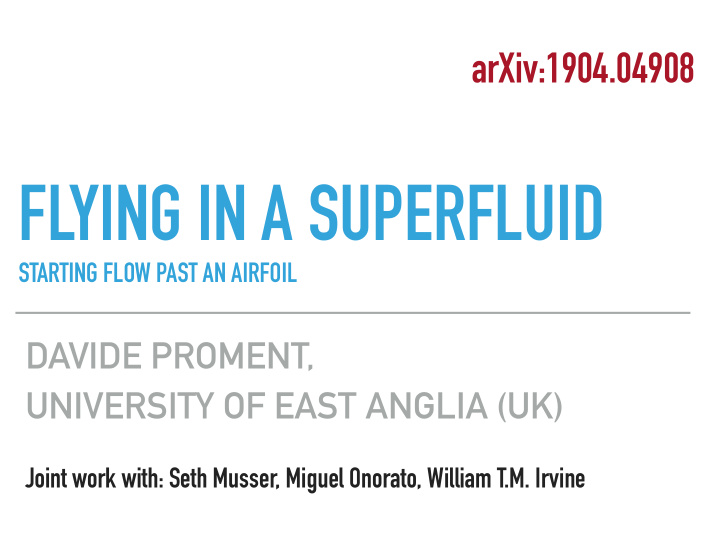



arXiv:1904.04908 FLYING IN A SUPERFLUID STARTING FLOW PAST AN AIRFOIL DAVIDE PROMENT, UNIVERSITY OF EAST ANGLIA (UK) Joint work with: Seth Musser, Miguel Onorato, William T.M. Irvine
CLASSICAL THEORY OF FLIGHT (2D) By Wright brothers - Library [M. Van Dyke, An Album of fluid Motion, 1982] of Congress, Public Domain [Wikipedia] ‣ Ideal theory: stationary flow, prediction of lift ‣ Viscous effects: explain generation of lift and drag effects [D.J. Achenson, Elementary Fluid Dynamics, Oxford University Press, 1990]
CLASSICAL THEORY OF FLIGHT (2D) Ideal theory (inviscid and incompressible): full family of stationary flows depending on ( α , U ∞ , L , Γ ) ‣ Kutta—Joukowski (KJ) condition Γ KJ = − π U ∞ L sin α ‣ lift per unit of wingspan of − ρ U ∞ Γ KJ
CLASSICAL THEORY OF FLIGHT (2D) Viscous effects ‣ viscous boundary layer around the airfoil ‣ viscosity allows the generation of the KJ circulation around an accelerated airfoil ‣ drag forces arise (form drag and skin drag)
FLYING IN A SUPERFLUID ‣ Can an accelerated airfoil acquire circulation? ‣ Is there a constrain similar to the Kutta— Joukowski condition? ‣ If so, does the airfoil experience any lift and/or drag?
THE GROSS-PITAEVSKII MODEL ∂ t + ℏ 2 ı ℏ ∂ ψ 2 m ∇ 2 ψ − g | ψ | 2 ψ − V ext ψ = 0 Madelung transformation u = ℏ / m ∇ ϕ , ρ = m | ψ | 2 ψ = ρ exp( ı ϕ ) ∂ ρ ∂ t + ∇ ⋅ ( ρ u ) = 0 given bulk density ρ 0 ∇ 2 ρ m V + ℏ 2 ∂ u ∂ t + ( u ⋅ ∇ ) u = ∇ − g m ρ + 1 ℏ 2 /(2 mg ρ 0 ) ξ = 2 m 2 ρ c = g ρ 0 / m ‣ inviscid, compressible, and irrotational fluid ‣ vortices are topological defects of quantum of circulation κ = h / m ‣ airfoil is modelled using a moving external potential whose V ext intensity is much larger than the chemical potential μ = g ρ 0
A TYPICAL SIMULATION ‣ airfoil accelerates until it reaches a terminal velocity U ∞ = 0.29 c ‣ the length is L = 325 ξ and angle of attack α = π /12 Top: evolution of the phase field. Bottom: evolution of the superfluid density field. Final stage: ‣ Emission of 4 quantised vortices at the trailing edge ‣ By conservation of total circulation, the circulation around the airfoil becomes Γ = 4 κ
EXPLORATION OF THE PARAMETERS SPACE ‣ We vary both the airfoil length and terminal velocity ‣ The airfoil shape and angle of attack are kept constant α = π /12 Left: number of vortices produced at the trailing edge. Vortices produced at the top are highlighted with a polygon. Right: two simulation examples, the latter with the detachment of the boundary layer causing a stall condition.
VORTEX GENERATION BY COMPRESSIBLE EFFECTS Introducing a dispersive boundary layer with thickness r = C ξ 2 sin 2 ( α ) ( 1 − Γ Γ KJ ) 2 ξ ( c ) U ∞ C ≤ 3 L 8 where Γ = n κ , with n ∈ ℕ and Γ KJ is the KJ condition best fit gives C ≈ 0.55 Number of vortices generated depending on the speed and length parameters. The curves indicate the phenomenological prediction. The white area indicate the stalling behaviour.
ABOUT LIFT AND DRAG Lift and drag is obtained from the stress-energy tensor F k = − ∮ 풞 2 δ jk g ρ 2 − ℏ 2 T jk = m ρ u j u k + 1 where T jk n j d ℓ , 4 m ρ ∂ j ∂ k ln ρ closed path containing the airfoil 풞 Left: video showing the sound emission during the vortex nucleation at the trailing edge. Right: rescaled lift (dashed) and drag (solid) versus time computed for different contours around the airfoil.
ABOUT LIFT AND DRAG (SOUND FILTERED) ‣ filter the acoustic component in the velocity field ‣ use density field prescribed by the stationary Bernoulli equation Rescaled lift (dashed) and drag (solid) versus time computed for different contours around the airfoil removing sound Lift appears now quantised and drag becomes nearly zero after the vortex nucleation
CONCLUSIONS ‣ An airfoil moving in a superfluid can generate vortices at the trailing edge due to compressible effects ‣ The number of vortices produced can be explained using the classical Kutta—Joukowski condition ‣ The (transient) nucleation process generates sound ‣ When sound is filtered (or let escape to infinity) the airfoil experiences a quantised lift and no drag arXiv:1904.04908
Recommend
More recommend